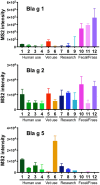Variability in German Cockroach Extract Composition Greatly Impacts T Cell Potency in Cockroach-Allergic Donors
- PMID: 30891032
- PMCID: PMC6413722
- DOI: 10.3389/fimmu.2019.00313
Variability in German Cockroach Extract Composition Greatly Impacts T Cell Potency in Cockroach-Allergic Donors
Abstract
German cockroach extract is used clinically to evaluate allergen-specific sensitization and for subcutaneous allergen-specific immunotherapy, though there are no guidelines for standardization in its manufacture. We performed an immunological evaluation of 12 different cockroach extracts prepared from different sources and their potency to induce allergen-specific T cell reactivity. PBMC from 13 cockroach allergic donors were expanded in vitro with 12 different German cockroach extracts. After culture expansion, cells were re-stimulated with the different extracts and T cell responses were assessed by FluoroSpot (IL-5, IFNγ and IL-10 production). In parallel to the extracts, single allergen peptide pools for allergens from groups 1, 2, 4, 5, and 11 were tested to determine allergen immunodominance. Furthermore, to assess allergy specificity, PBMC from 13 non-allergic donors were also tested with the most potent extract and T cell responses were compared to the allergic cohort. Dramatic variations in T cell reactivity were observed to the different cockroach extract batches. Response magnitudes varied over 3 logs within a single donor. IL-5 production in the allergic cohort was significantly higher compared to the non-allergic cohort (p=0.004). Allergen content determination by ELISA detected much lower concentrations of Bla g 5 compared to Bla g 1 and 2. Mass spectrometric analysis revealed that Bla g 5 was present in similar amounts to Bla g 1 and 2 in extracts made from whole body, whereas it was not detected in extracts made from fecal matter, suggesting that Bla g 5 is not excreted into feces. Different donors exhibit different response patterns to different extracts, potentially dependent on the donor-specific T cell allergen immunodominance pattern and the allergen content of the extract tested. These findings have dramatic implications for the selection of potent extracts used for diagnostic purposes or allergen-specific immunotherapy.
Keywords: German cockroach; T cells; allergen extract; cytokines; respiratory allergy.
Figures






Similar articles
-
Allergen content in German cockroach extracts and sensitization profiles to a new expanded set of cockroach allergens determine in vitro extract potency for IgE reactivity.J Allergy Clin Immunol. 2019 Apr;143(4):1474-1481.e8. doi: 10.1016/j.jaci.2018.07.036. Epub 2018 Aug 28. J Allergy Clin Immunol. 2019. PMID: 30170124 Free PMC article.
-
IgE and T Cell Reactivity to a Comprehensive Panel of Cockroach Allergens in Relation to Disease.Front Immunol. 2021 Feb 10;11:621700. doi: 10.3389/fimmu.2020.621700. eCollection 2020. Front Immunol. 2021. PMID: 33643303 Free PMC article.
-
Comparison of allergenic components between German cockroach whole body and fecal extracts.Ann Allergy Asthma Immunol. 2001 May;86(5):551-6. doi: 10.1016/S1081-1206(10)62904-3. Ann Allergy Asthma Immunol. 2001. PMID: 11379807
-
Recombinant allergens for diagnosis of cockroach allergy.Curr Allergy Asthma Rep. 2014 Apr;14(4):428. doi: 10.1007/s11882-014-0428-6. Curr Allergy Asthma Rep. 2014. PMID: 24563284 Free PMC article. Review.
-
Allergen dose dependent cytokine production regulates specific IgE and IgG antibody production.Adv Exp Med Biol. 1996;409:295-303. doi: 10.1007/978-1-4615-5855-2_42. Adv Exp Med Biol. 1996. PMID: 9095257 Review.
Cited by
-
Development and Validation of a Bordetella pertussis Whole-Genome Screening Strategy.J Immunol Res. 2020 Apr 2;2020:8202067. doi: 10.1155/2020/8202067. eCollection 2020. J Immunol Res. 2020. PMID: 32322598 Free PMC article.
-
Allergic Asthma in Children: The Hidden Role of Cockroaches.Pediatr Pulmonol. 2025 Jul;60(7):e71211. doi: 10.1002/ppul.71211. Pediatr Pulmonol. 2025. PMID: 40693559 Free PMC article. No abstract available.
-
Cockroach immunotherapy modulates dominant T-cell responses independent of allergen extract content.J Allergy Clin Immunol. 2025 Jul 24:S0091-6749(25)00798-5. doi: 10.1016/j.jaci.2025.07.011. Online ahead of print. J Allergy Clin Immunol. 2025. PMID: 40714043
-
Ampicillin treated German cockroach extract leads to reduced inflammation in human lung cells and a mouse model of Asthma.Parasites Hosts Dis. 2023 Feb;61(1):60-71. doi: 10.3347/PHD.22147. Epub 2023 Feb 22. Parasites Hosts Dis. 2023. PMID: 37170465 Free PMC article.
-
Ex vivo assays show human gamma-delta T cells specific for common allergens are Th1-polarized in allergic donors.Cell Rep Methods. 2022 Nov 21;2(12):100350. doi: 10.1016/j.crmeth.2022.100350. eCollection 2022 Dec 19. Cell Rep Methods. 2022. PMID: 36590684 Free PMC article.
References
-
- Yi MH, Jeong KY, Kim CR, Yong TS. IgE-binding reactivity of peptide fragments of Bla g 1.02, a major German cockroach allergen. Asian Pac J Aller. Immunol. (2009) 27:121–9. - PubMed
Publication types
MeSH terms
Substances
Grants and funding
LinkOut - more resources
Full Text Sources
Medical

